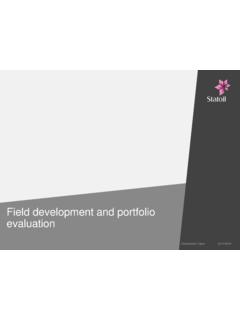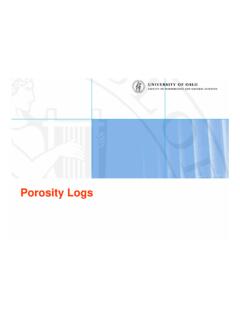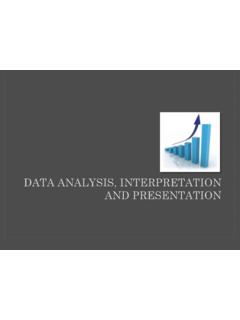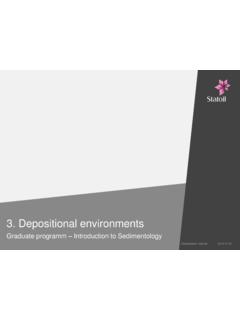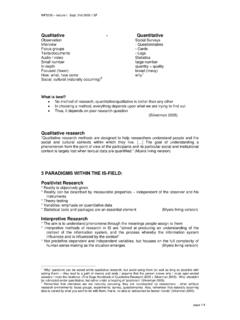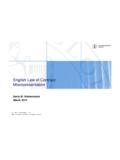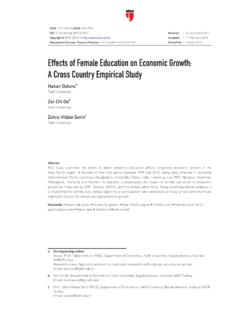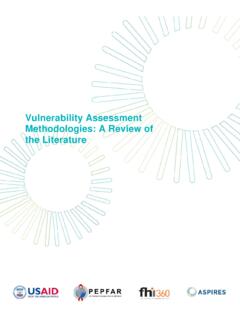Transcription of Panel Data Analysis — Advantages and Challenges
1 Sociedad de Estad stica e Investigaci on OperativaTest(0000) , , 63 Panel Data Analysis Advantages and ChallengesCheng Hsiao Department of Economics, University of Southern California, USAWang Yanan Institute for Studies in Economics, Xiamen University, ChinaAbstractWe explain the proliferation of Panel data studies in terms of (i) data availability,(ii) the more heightened capacity for modeling the complexity of human behaviorthan a single cross-section or time series data can possiblyallow, and (iii) challeng-ing methodology. Advantages and issues of Panel data modeling are also Words: Panel data, longitudinal data, unobserved heterogeneity,randomeffects, fixed subject classification:62-021 IntroductionPanel data or longitudinal data typically refer to data containing time seriesobservations of a number of individuals.
2 Therefore, observations in paneldata involve at least two dimensions; a cross-sectional dimension, indicatedby subscripti, and a time series dimension, indicated by subscriptt. How-ever, Panel data could have a more complicated clustering orhierarchicalstructure. For instance, variableymay be the measurement of the level ofair pollution at station`in cityjof countryiat timet( ,2001;Davis,2002). For ease of exposition, I shall confine my presentationto a balanced Panel involvingNcross-sectional units,i= 1,..,N, overTtime periods,t= 1,.., is a proliferation of Panel data studies, be it methodological orempirical.
3 In 1986, whenHsiao s (1986) first edition ofPanel Data Analysiswas published, there were 29 studies listing the key words: Panel data or Correspondence to: Cheng Hsiao. Department of Economics, University of SouthernCalifornia, Los Angeles, CA 90089-0253, USA. E-mail: Hsiaolongitudinal data , according to Social Sciences Citationindex. By 2004,there were 687 and by 2005, there were 773. The growth of applied studiesand the methodological development of new econometric tools of paneldata have been simply phenomenal since the seminal paper ofBalestra andNerlove(1966).
4 There are at least three factors contributing to the geometric growth ofpanel data studies. (i) data availability, (ii) greater capacity for modelingthe complexity of human behavior than a single cross-section or time seriesdata, and (iii) challenging methodology. In what follows, we shall brieflyelaborate each of these one by one. However, it is impossibleto do justice tothe vast literature on Panel data. For further reference, seeArellano(2003),Baltagi(2001),Hsiao(20 03),M aty as and Sevestre(1996), andNerlove(2002), Data availabilityThe collection of Panel data is obviously much more costly than the col-lection of cross-sectional or time series data.
5 However, Panel data havebecome widely available in both developed and developing two most prominent Panel data sets in the US are the NationalLongitudinal Surveys of Labor Market Experience (NLS) and the Universityof Michigan s Panel Study of Income Dynamics (PSID). The NLSbegan inthe mid 1960 s. It contains five separate annual surveys covering distinctsegments of the labor force with different spans: men whose ages were 45to 59 in 1966, young men 14 to 24 in 1966, women 30 to 44 in 1967, youngwomen 14 to 24 in 1968, and youth of both sexes 14 to 21 in 1979. In 1986,the NLS expanded to include annual surveys of the children born to womenwho participated in the National Longitudinal Survey of Youth 1979.
6 Thelist of variables surveyed is running into the thousands, with emphasis onthe supply side of PSID began with collection of annual economic information from arepresentative national sample of about 6,000 families and15,000 individ-uals in 1968 and has continued to the present. The data set contains over5,000 variables (Becketti et al.,1988). In addition to the NLS and PSID data sets, there are many other Panel data sets that could be of interest toeconomists, seeJuster(2000). Panel Data Analysis3In Europe, many countries have their annual national or morefrequentsurveys such as the Netherlands Socio-Economic Panel (SEP), the GermanSocial Economics Panel (GSOEP), the Luxembourg Social Panel (PSELL),the British Household Panel Survey (BHS), etc.
7 Starting in 1994, the Na-tional Data Collection Units (NDUS) of the Statistical Officeof the Eu-ropean Committees have been coordinating and linking existing nationalpanels with centrally designed multi-purpose annual longitudinal European Community Household Panel (ECHP) are published in Eu-rostat s reference data base New Cronos in three domains: health, housing,and income and living data have also become increasingly available in developing coun-tries. In these countries, there may not have been a long tradition of sta-tistical collection. It is of special importance to obtain original survey datato answer many significant and important questions.
8 Many internationalagencies have sponsored and helped to design Panel instance,the Dutch non-government organization (NGO), ICS, Africa,collaboratedwith the Kenya Ministry of Health to carry out a Primary School Deworm-ing Project (PDSP). The project took place in Busia district, a poor anddensely-settled farming region in western Kenya. The 75 project schoolsinclude nearly all rural primary schools in this area, with over 30,000 en-rolled pupils between the ages of six to eighteen from 1998-2001. Anotherexample is the development Research Institute of the Research Center forRural development of the State Council of China, in collaboration withthe World Bank, which undertook an annual survey of 200 largeChinesetownship and village enterprises from 1984 to Advantages of Panel dataPanel data, by blending the inter-individual differences and intra-individualdynamics have several Advantages over cross-sectional or time-series data:(i) More accurate inference of model parameters.
9 Panel datausuallycontain more degrees of freedom and more sample variabilitythancross-sectional data which may be viewed as a Panel withT= 1, ortime series data which is a Panel withN= 1, hence improving theefficiency of econometric estimates ( et al.,1995).4C. Hsiao(ii) Greater capacity for capturing the complexity of humanbehaviorthan a single cross-section or time series data. These include:( ) Constructing and testing more complicated behavioral hypothe-ses. For instance, consider the example ofBen-Porath(1973)that a cross-sectional sample of married women was found tohave an average yearly labor-force participation rate of 50per-cent.
10 These could be the outcome of random draws from a ho-mogeneous population or could be draws from heterogeneouspopulations in which 50% were from the population who alwayswork and 50% never work. If the sample was from the former,each woman would be expected to spend half of her marriedlife in the labor force and half out of the labor force. The jobturnover rate would be expected to be frequent and the aver-age job duration would be about two years. If the sample wasfrom the latter, there is no turnover. The current informationabout a woman s work status is a perfect predictor of her futurework status.
